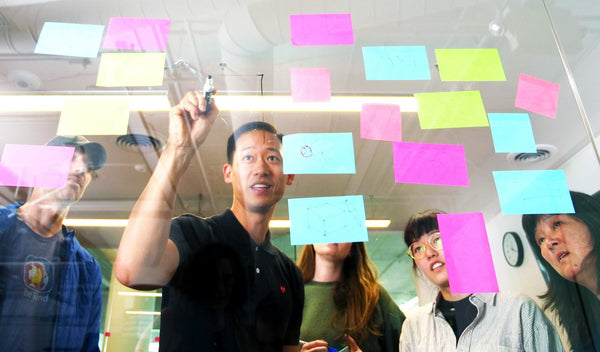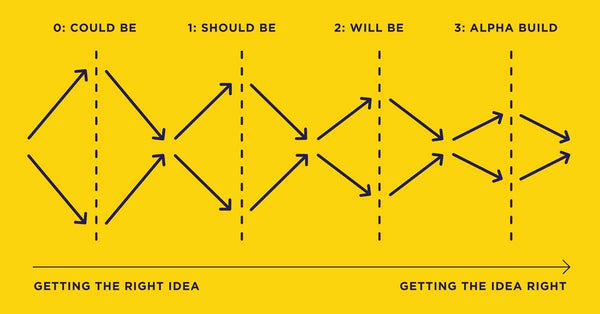To Unlock Innovation, Guide Your Team Through Creative Collaboration
“We need to have some sort of structure in order for creativity to thrive.”
—Mike Peng, IDEO Partner and Managing Director

In this episode of our Creative Confidence Series, IDEO Partner and Managing Director Mike Peng chats with IDEO U Dean Suzanne Gibbs Howard about creative collaboration—the method IDEO teams use to come up with innovative new ideas. Mike gives insight into our new course, Cultivating Creative Collaboration, that teaches you how to guide others through the creative collaboration process. He also shares tips for overcoming common challenges, why this way of working is necessary in today’s world, and how tension can be harnessed to unleash creative ideas.
Listen on Apple Podcasts or Spotify
What does it mean to collaborate with others? The more common understanding might conjure images of a track team executing smooth baton handoffs or a dance troupe moving in sync. But today’s business challenges are only getting more complex. We’re asking teams to do more than execute on an existing plan in a more efficient way—we need them to come up with completely new ideas. And that requires a different type of teamwork.
There is no one single answer to today’s types of challenges, says Mike Peng, IDEO Partner and Managing Director of the Tokyo office. “That means that we need to come at problems from a lot of different perspectives.”
Mike has been leading teams at IDEO to come up with innovative solutions for 13 years. Over those years, he’s fine-tuned the methods and techniques needed to guide teams through a choreographed creative process that goes far beyond one brainstorming session. In our newest course, Cultivating Creative Collaboration, Mike shares how to set the scene for this type of teamwork and keep a team on track through multiple rounds of work.
“It's very powerful to bring in creative collaboration when you don't know what the answer is.”
Mike Peng
What is creative collaboration?
Creative collaboration harnesses the power of diverse perspectives and creativity to develop innovative solutions. The goal of this type of teamwork is to come up with new ideas.
“It's very powerful to bring in creative collaboration when you don't know what the answer is, and you're open to having different types of solutions come about,” Mike explains.
Bringing a larger group of people together increases the number of ideas you can generate. Sourcing a diversity of perspectives expands the kinds of ideas that will surface. Fostering a culture that encourages and welcomes those ideas improves the likelihood that people will feel comfortable pushing beyond the safe ideas and sharing the more risky, scary, and potentially genius ones.
Mike recalls a project IDEO did in Thailand centered around the question “How do we motivate a whole new generation of farmers to get excited about farming again?” Farming contributes to a large part of Thailand’s economy, but younger generations were showing signs of disinterest in the industry. This challenge was big, ambiguous, and in need of a radically new solution—the perfect candidate for creative collaboration.
The IDEO team started by gathering a wide range of stakeholders. While the original hypothesis assumed higher crop yield would lead to greater job satisfaction, the team found that younger farmers were motivated by the ability to bring other interests, like uniform design, into the farming world so they could expand the definition of what it meant to be a farmer.
“Bringing farmers together along with the company themselves, designers, and different types of creative collaborators, I think we came to a solution that none of us, individually, would have been able to think about alone,” Mike says.
Think of creative collaboration as “a way of thinking that helps teams of all sizes and teams from all different types of industries come together to try and navigate ambiguity.”
The two modes of creative collaboration
While it might appear messy and spontaneous from the outside, gathering the right people is just the starting point in a more thoughtful process. Enabling a team to come up with wild new ideas takes intention and planning.
“Collaborating doesn't mean just getting a bunch of people into a room and letting a free-for-all happen,” Mike says.
There are two main modes of thinking in the creative collaboration process: divergence and convergence. In divergence, teams go wide with ideas. In convergence, you narrow in on what’s most important. A common misconception is to think of these modes as linear—that you start broad and get increasingly more narrow with your focus.
But it’s not so much a funnel as it is “a dance of going out, coming in, going out, coming in, until we get to the best solution.”

While divergent moments are designed to come up with as many ideas as possible, Mike says “we need to have some sort of structure in order for creativity to thrive.” Most people can see the value in gathering a group to come up with ideas, but Mike reminds us that “convergence can also be a creative activity as well.” Narrowing in on the best ideas is often an exercise in combining the best elements of existing concepts into a completely new option—a process that benefits from multiple perspectives and discussion.
Understanding these two modes of thinking will set a strong foundation for creative collaboration. As a leader—whether you’re managing a team or guiding a cross-functional group through a project—your role is to signal what stage of the process the team is in, the mindsets they should embody at any given moment, and when to shift gears. This takes practice and experience that can only be developed by going through the creative process many times.
Tension is your friend
“Tension can be very, very productive for creative collaboration,” Mike ensures. Instead of rushing to diffuse it, try to manage tension.
The kind of tension that holds the opportunity for innovation is tension between ideas—when people have different perspectives on how to achieve a shared goal and strong opinions about how to move forward.
This type of tension comes up naturally in a group setting, especially one where you’ve gathered a wide range of perspectives. In fact, if that tension isn’t there, Mike says it’s a sign that “we're obviously not pushing on each other to make our ideas better.”
In order to manage these tensions, it’s critical to prepare in advance. Mike works with his teams to create a set of constraints that everyone can use to evaluate ideas and decisions. Then, once you’re in the moment, it’s easier to evaluate if an idea is inside or outside of the “box” you’ve set for yourself. If it’s in the box, that’s your opportunity for a really valuable conversation.
“You get to that point, and you feel that friction in the room—we call it a hot spot—and you know that's the place where innovation has to come about because that's where people are holding too tightly to preconceived notions,” Mike says.
“You know that's the place where innovation has to come about because that's where people are holding too tightly to preconceived notions.”
Mike Peng
How to dodge common hurdles to collaboration
Each step of the creative collaboration process holds different challenges. The person who is guiding a team through this journey has to be aware of potential roadblocks in order to keep things moving in a productive way.
When diverging with a group, Mike says it can be easy for judgment to slip in, preventing a team from exploring what may ultimately be some of their best ideas. If you notice this behavior, push back on your team.
“If we're all on the same page to create solutions that we haven't thought about before, we need to be okay with having ideas that we haven't thought about before,” Mike says. “And sometimes that can be really uncomfortable.”
Shifting to convergence mode too early is another mistake. Even if some great ideas have surfaced, he says “if you can just hold back a little and let the process flow, I think you'd be really surprised at what would come out.”
When you’re ready to converge and start making decisions, don’t limit yourself to selecting one of the existing ideas. Out of five concepts, your team may unearth a sixth by pulling in the best pieces of a few options. But make sure to avoid trying to appease everyone in the room by mixing and mashing every idea together. Creating a Franken-concept based on ego and personal attachment to ideas will hold your team back.
Working with remote teams can also be challenging, but Mike thinks it’s ultimately a benefit. “Being remote enables us to be in touch with so many more people than we had at our disposal before.” And more people means more ideas.
He says to plan ahead: consider gathering input from a colleague in a different time zone ahead of a brainstorm, asking for their help in synthesizing ideas, and generally benefiting from the different perspective they will bring to the conversation.
Cultivate your ability to guide creative collaboration
This kind of teamwork has enabled IDEO to come up with groundbreaking concepts, products, and services across many industries and many decades. And the ability to think creatively is in high demand. Nearly 60% of CEOs cited creativity as the most important leadership quality in an IBM survey. As teams are increasingly asked to generate creative solutions to new and difficult business challenges, the need for creative collaboration—and people who can facilitate this unique flavor of teamwork—will only increase.
Get more tips and techniques from Mike on guiding collaboration in our new 5-week online course, Cultivating Creative Collaboration, starting May 23rd.
- choosing a selection results in a full page refresh
- press the space key then arrow keys to make a selection



